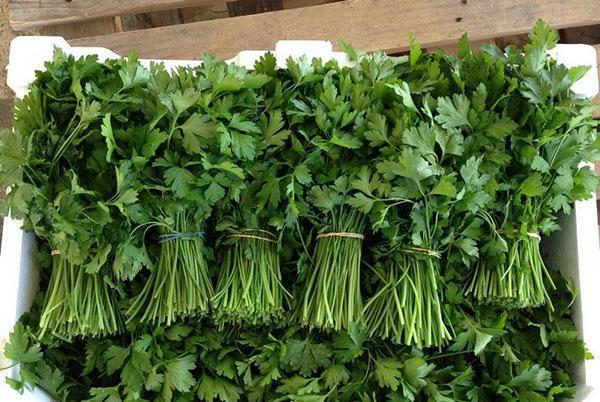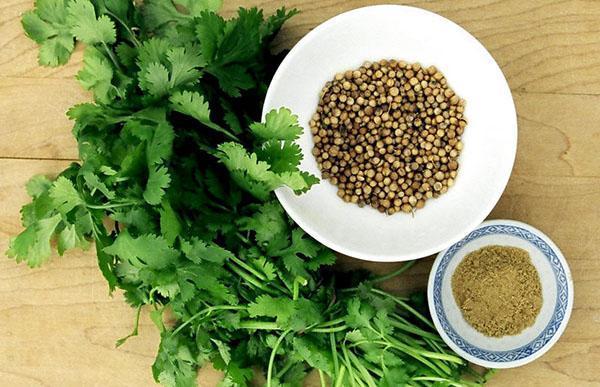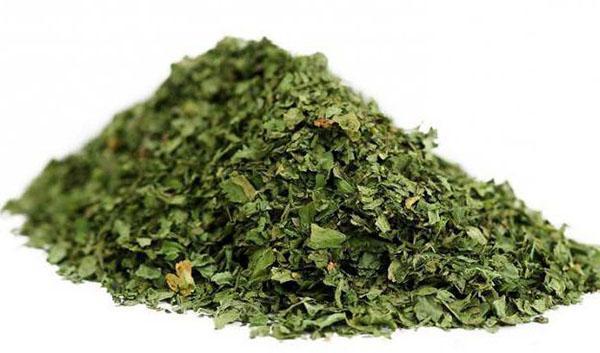Traditional methods and recipes of the peoples of the world for preparing cilantro for the winter
 Cilantro, cilantro, coriander - all these are the names of one spicy culture, widely known and beloved in the East, Europe and the American continent. Coriander is more commonly referred to as the entire plant and its round seeds, used to flavor culinary dishes, pickles, marinades and baked goods. And the Caucasian name "cilantro" and the South American "silantro" mean fragrant greens.
Cilantro, cilantro, coriander - all these are the names of one spicy culture, widely known and beloved in the East, Europe and the American continent. Coriander is more commonly referred to as the entire plant and its round seeds, used to flavor culinary dishes, pickles, marinades and baked goods. And the Caucasian name "cilantro" and the South American "silantro" mean fragrant greens.
No wonder it was cilantro in the Caucasus, in the land of centenarians, they season meat dishes. Regular consumption of herbs with a sharp, fresh aroma has a positive effect on blood pressure and blood supply. The substances contained in the leaves of cilantro stimulate the production of gastric juice, promote the speedy digestion of fatty meat food, and cleanse the body.
Both the foliage and the seeds of coriander contain a lot of essential oils, vitamins, organic acids and other biologically active substances, thanks to which the seasoning has a pronounced beneficial effect on the general condition of the body and its defenses.
In the summer, when vitamins literally "grow in the beds", it doesn't cost anything to add a couple of sprigs of spicy herbs to a salad or meat stew. But what to do in winter when this type of greenery is not so available? How to preserve cilantro for the winter, and what can be prepared from this wonderful plant for future use?
How to keep cilantro for the winter?

To collect condensation that forms inside the container, you can lay a napkin, which will have to be changed from time to time.
But no matter how much you want to prepare cilantro for the winter in its original form, it is unlikely that this will succeed. But you shouldn't despair. The crop grown in the beds will not be lost. If you use the numerous recipes for preparing cilantro for the winter, including drying, salting, freezing and other processing methods.
Harvesting dried cilantro for the winter
 Drying is one of the simplest and most common ways to preserve the beneficial properties and aroma of herbs for a long time. If all the rules are followed, the temperature and duration of the process are maintained, then the crushed cilantro leaves retain their taste and aroma throughout the year and can be used to add to sauces and hot dishes.
Drying is one of the simplest and most common ways to preserve the beneficial properties and aroma of herbs for a long time. If all the rules are followed, the temperature and duration of the process are maintained, then the crushed cilantro leaves retain their taste and aroma throughout the year and can be used to add to sauces and hot dishes.
Before preparing cilantro for the winter in this way:
- the stems and leaves are washed;
- remove all rough and damaged parts of the plant;
- the greens are carefully dried so that no traces of water remain on the raw materials for drying.
Gourmets claim that the pungent smell of cilantro becomes softer if the greens are chopped before use or processing.
Therefore, young parts of shoots and leaf plates are cut, and then laid out in a thin even layer on clean baking sheets. Harvesting cilantro for the winter using drying is carried out in a dry, ventilated room. Plant materials should be located away from direct sunlight and heat sources with temperatures above 40 ° C.If greens are dried in an oven or electric dryer, it is important to provide cilantro with the same temperature regime and monitor the process all the time so that the raw materials do not stick together and the moisture loss goes evenly.
Pour the dried cilantro into a clean glass or ceramic dish with tight-fitting lids. In a cool, dark place, spicy herbs can be stored for about a year, fully retaining all the active substances, aroma and taste inherent in cilantro. Similarly, coriander seeds are dried, which in winter will be useful for making aromatic bread, adding to sauces, minced meat and poultry dishes.
Spicy oil based on coriander seeds and herbs
 On the basis of dried cilantro and the seeds of this plant, you can prepare a spicy oil for dressing salads, making homemade mayonnaise and marinades. For this, crushed parts of a plant or whole stems, as well as coriander umbrellas, are poured with any vegetable oil and left in a glass container for 8-10 days in a cool dark place. Cilantro, rich in aromatic substances and essential oils, already during this period some of them transfer liquids.
On the basis of dried cilantro and the seeds of this plant, you can prepare a spicy oil for dressing salads, making homemade mayonnaise and marinades. For this, crushed parts of a plant or whole stems, as well as coriander umbrellas, are poured with any vegetable oil and left in a glass container for 8-10 days in a cool dark place. Cilantro, rich in aromatic substances and essential oils, already during this period some of them transfer liquids.
If you leave the vegetable raw materials for a longer period, the oil acquires a rich red-brown hue and a sweetish-spicy aroma.
And from fresh greens of cilantro, basil and other spices based on olive oil, you can prepare and save for the winter a spicy dressing for cereals and potatoes.
To prepare it you will need:
- 1 cup fresh green basil leaves
- 1 cup chopped young cilantro stems and leaves
- 1 clove, peeled and minced garlic;
- 1/2 pod of peeled jalapeno peppers
- 1/2 cup olive oil
Vegetables for such a preparation of cilantro for the winter are pre-peeled, mine and chopped in a blender, after which olive oil is gradually added to the bowl and the mass is gently mixed again until a homogeneous puree is obtained. The dressing, poured into a glass container, will be ready after a month of storage in a dark, cool place.
If desired, you can add a little lemon juice and salt to the aromatic oil. In this case, the sauce can be served with meat, mushrooms and baked vegetables.
Is it possible to freeze cilantro for the winter? Yes, and in this case, vegetable or butter will come in handy, and the greens that have retained all their useful qualities will turn into an excellent seasoning for vegetable and meat dishes, sandwiches, rice and pasta.
Freezing greens: recipes for preparing cilantro for the winter
 Low temperatures allow not only to preserve cilantro for the winter, but also to preserve all the vitamins and active substances in its composition. The simplest way to freeze cilantro is:
Low temperatures allow not only to preserve cilantro for the winter, but also to preserve all the vitamins and active substances in its composition. The simplest way to freeze cilantro is:
- in the preliminary bulkhead and green washing;
- drying it thoroughly on a paper or cloth towel;
- in crushing and distribution in tight bags.
After that, the closed containers with spicy herbs are removed to the freezer, where the herbs are to be stored. If, according to this recipe, not only cilantro, but also other herbs are harvested for the winter, it is better to sign the packages in advance in order to further facilitate the recognition of green raw materials.
Portion cubes based on chopped cilantro greens are enjoyed by an increasing number of housewives. Making them at home is not difficult at all. The foliage and juicy parts of the stalks are crushed, and the resulting mass is laid out in ice molds or other small containers. The water added to the crushed greens holds them together, giving the cilantro, harvested for the winter, a cube shape.
Instead of water, you can add melted butter or olive oil, as well as garlic and lemon juice, with which cilantro goes well.
Snack butter with cilantro and vegetables for the winter
Butter, like vegetable oil, helps greens and all of its beneficial properties to survive almost until next spring.
To use such a recipe and save cilantro for the winter, chop the greens, mix thoroughly with softened butter and, putting them on cling film or a sheet of parchment, form a bar convenient for storage and subsequent cutting. In a freezer, butter with cilantro is stored for 3 to 6 months, but the product can be used when cooking rice and potatoes, minced meat and pasta.
 If desired, in addition to cilantro, add green and mild onions, garlic and lemon zest, pieces of sweet pepper and other spicy crops.
If desired, in addition to cilantro, add green and mild onions, garlic and lemon zest, pieces of sweet pepper and other spicy crops.
A little table salt will help the savory oil last longer, and the vegetables and herbs in it, stay juicy, like when harvested from the garden.
How to keep cilantro for the winter: marinade recipe
 The addition of vinegar contributes to the long shelf life of foods, and cilantro greens are no exception. The simplest recipe for preparing cilantro for the winter involves pouring chopped greens with a marinade of 300 ml of water, a pinch of salt and a tablespoon of 9 percent vinegar.
The addition of vinegar contributes to the long shelf life of foods, and cilantro greens are no exception. The simplest recipe for preparing cilantro for the winter involves pouring chopped greens with a marinade of 300 ml of water, a pinch of salt and a tablespoon of 9 percent vinegar.
Tightly packed glass jars with spicy foliage:
- pour the finished marinade:
- let it brew;
- then add a little vegetable oil on top;
- close containers with lids.
Cilantro prepared according to this recipe for the winter will improve the taste of salads, sauces for meat and vegetable stews. Store herbs under the marinade in the refrigerator or cellar.
Cilantro chutney with garlic and nuts
 Fans of oriental cuisine can use the recipe for preparing cilantro for the winter, where the seeds of this plant are used along with herbs. Walnut kernels and garlic are chopped, chopped onions, cilantro and parsley are added to the same container. A small pod of peeled hot pepper will add spice to the seasoning.
Fans of oriental cuisine can use the recipe for preparing cilantro for the winter, where the seeds of this plant are used along with herbs. Walnut kernels and garlic are chopped, chopped onions, cilantro and parsley are added to the same container. A small pod of peeled hot pepper will add spice to the seasoning.
Dried ground coriander grains, turmeric, fenugreek, paprika and salt are added to chopped vegetables and herbs to taste. Water mixed with wine white vinegar is used as a marinade. For 50 ml of boiled water, you need 3 tablespoons of vinegar. Add enough liquid to the mixture to make a thick paste, while the sauce, without stopping, gently stir.
The prepared seasoning, prepared from cilantro for the winter, is laid out in jars and stored in the cold. Serve chutney with fried zucchini or eggplant slices, add sauce to rice or couscous.
Cilantro chimichurri sauce
 To prepare the famous Latin American chimichurri sauce, which is seasoned with corn steaks of their juicy beef and unleavened cakes stuffed with mushrooms and vegetables, you will need:
To prepare the famous Latin American chimichurri sauce, which is seasoned with corn steaks of their juicy beef and unleavened cakes stuffed with mushrooms and vegetables, you will need:
- 1 large bunch of cilantro, peeled from rough petioles and stems;
- 8 cloves of garlic;
- 3 tablespoons red wine vinegar
- juice of one lime;
- 70 grams toasted pumpkin seeds
- 1/2 cup olive oil
- some red pepper, ground or finely chopped;
- salt to taste.
 All components, except for olive oil, are ground and mixed in a blender until puree, then the oil is carefully poured in, and the sauce is mixed again, achieving a smooth homogeneous mass. Add salt, lemon or lime juice, and wine vinegar to your liking. The main note to the taste of the seasoning is given by cilantro and garlic. Such a cilantro blank for the winter is packed in small glass jars and stored in a refrigerator.
All components, except for olive oil, are ground and mixed in a blender until puree, then the oil is carefully poured in, and the sauce is mixed again, achieving a smooth homogeneous mass. Add salt, lemon or lime juice, and wine vinegar to your liking. The main note to the taste of the seasoning is given by cilantro and garlic. Such a cilantro blank for the winter is packed in small glass jars and stored in a refrigerator.